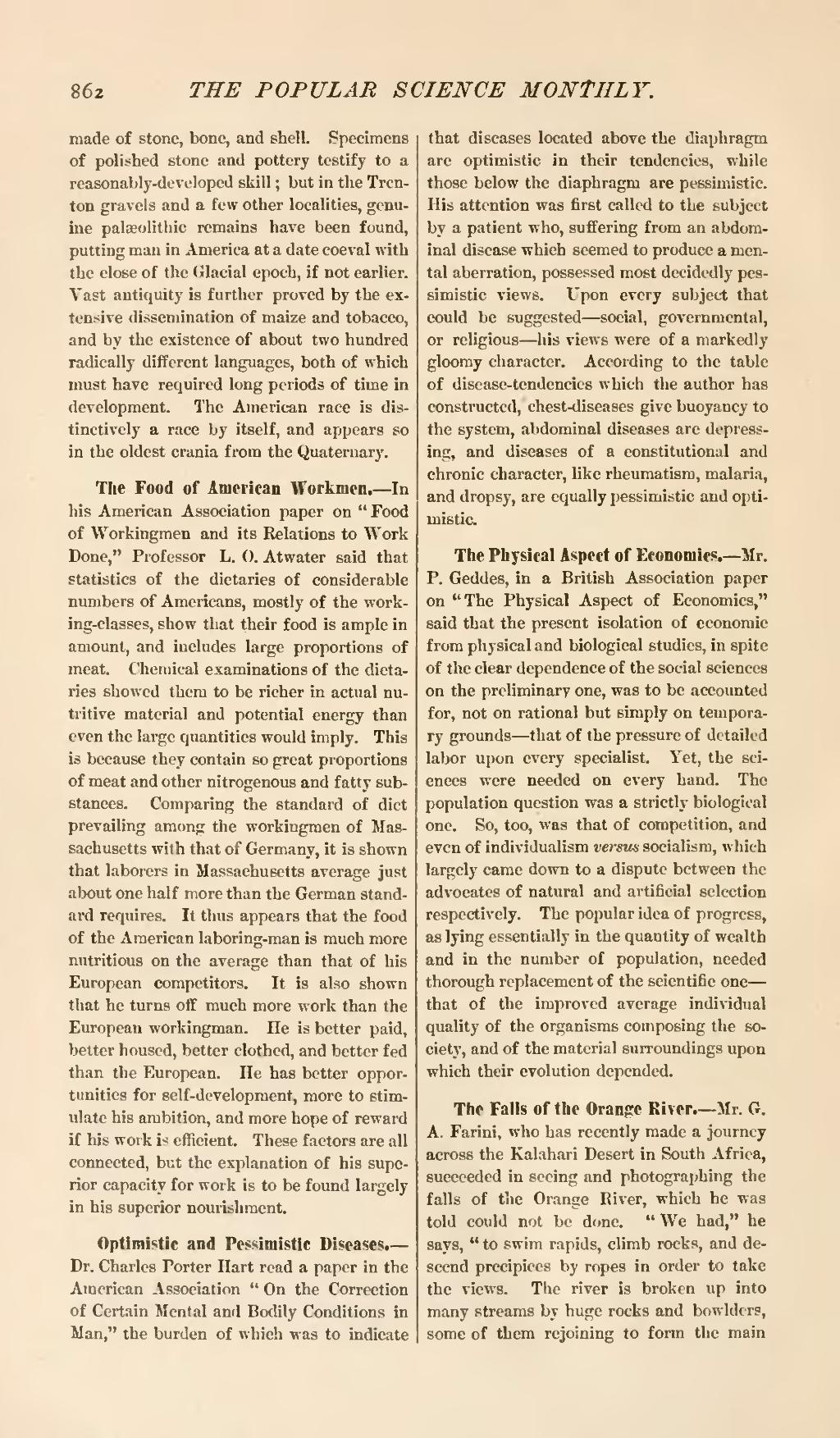made of stone, bone, and shell. Specimens of polished stone and pottery testify to a reasonably-developed skill; but in the Trenton gravels and a few other localities, genuine palæolithic remains have been found, putting man in America at a date coeval with the close of the Glacial epoch, if not earlier. Vast antiquity is further proved by the extensive dissemination of maize and tobacco, and by the existence of about two hundred radically different languages, both of which must have required long periods of time in development. The American race is distinctively a race by itself, and appears so in the oldest crania from the Quaternary.
The Food of American Workmen.—In his American Association paper on "Food of Workingmen and its Relations to Work Done," Professor L. O. Atwater said that statistics of the dietaries of considerable numbers of Americans, mostly of the working-classes, show that their food is ample in amount, and includes large proportions of meat. Chemical examinations of the dietaries showed them to be richer in actual nutritive material and potential energy than even the large quantities would imply. This is because they contain so great proportions of meat and other nitrogenous and fatty substances. Comparing the standard of diet prevailing among the workingmen of Massachusetts with that of Germany, it is shown that laborers in Massachusetts average just about one half more than the German standard requires. It thus appears that the food of the American laboring-man is much more nutritious on the average than that of his European competitors. It is also shown that he turns off much more work than the European workingman. He is better paid, better housed, better clothed, and better fed than the European. He has better opportunities for self-development, more to stimulate his ambition, and more hope of reward if his work is efficient. These factors are all connected, but the explanation of his superior capacity for work is to be found largely in his superior nourishment.
Optimistic and Pessimistic Diseases.—Dr. Charles Porter Hart read a paper in the American Association "On the Correction of Certain Mental and Bodily Conditions in Man," the burden of which was to indicate that diseases located above the diaphragm are optimistic in their tendencies, while those below the diaphragm are pessimistic. His attention was first called to the subject by a patient who, suffering from an abdominal disease which seemed to produce a mental aberration, possessed most decidedly pessimistic views. Upon every subject that could be suggested—social, governmental, or religious—his views were of a markedly gloomy character. According to the table of disease-tendencies which the author has constructed, chest-diseases give buoyancy to the system, abdominal diseases are depressing, and diseases of a constitutional and chronic character, like rheumatism, malaria, and dropsy, are equally pessimistic and optimistic.
The Physical Aspect of Economics.—Mr. P. Geddes, in a British Association paper on "The Physical Aspect of Economics," said that the present isolation of economic from physical and biological studies, in spite of the clear dependence of the social sciences on the preliminary one, was to be accounted for, not on rational but simply on temporary grounds—that of the pressure of detailed labor upon every specialist. Yet, the sciences were needed on every hand. The population question was a strictly biological one. So, too, was that of competition, and even of individualism versus socialism, which largely came down to a dispute between the advocates of natural and artificial selection respectively. The popular idea of progress, as lying essentially in the quantity of wealth and in the number of population, needed thorough replacement of the scientific one—that of the improved average individual quality of the organisms composing the society, and of the material surroundings upon which their evolution depended.
The Falls of the Orange River.—Mr. G. A. Farini, who has recently made a journey across the Kalahari Desert in South Africa, succeeded in seeing and photographing the falls of the Orange River, which he was told could not be done. "We had," he says, "to swim rapids, climb rocks, and descend precipices by ropes in order to take the views. The river is broken up into many streams by huge rocks and bowlders, some of them rejoining to form the main
